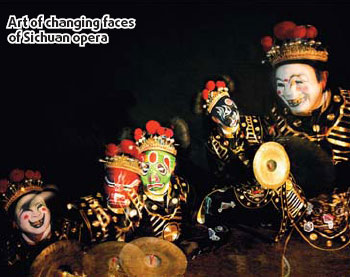

Visitors to Chengdu, the capital city of southwest China's Sichuan province, often enjoy a pleasant evening in a teahouse or theater watching Sichuan opera to amuse themselves with the magical art.
China has many styles of opera, the variations of which can confuse people, especially foreigners. But Sichuan's technique of "changing face" makes it easily distinguishable from others.
As a well-known major stunt in the opera, face-changing appeals to audiences worldwide. A performer usually changes dozens of masks within minutes and reverts to several masks after revealing his true face, a move usually met with deafening applause.
It is said that ancient people painted their faces to drive away wild animals. Sichuan opera absorbed the ancient custom and perfected it into an art. The technique was first introduced in an opera named Guizheng Pavilion in late Ming Dynasty (1368-1644), which tells the story of how the hero changes his appearance to avoid an army search. In the very beginning, performers layered paper masks on their faces and took them off from time to time under the cover of smoke on the stage and fans in their hands.

Audiences are keenly curious about the process. By raising a hand, swinging a sleeve or tossing their head, actors don different looks to show different emotions. From green to blue, red, yellow, brown, black, dark and gold, these masks show fear, tension, relaxation, slyness, desperation, outrage and more.
There are actually three types of face changes - pulling the mask, wiping it and blowing the mask. The most complex is the pulling technique. Masks are painted on pieces of damask, well cut, hung with a silk thread and then lightly pasted to the face one by one. The silk thread is fastened at an inconspicuous part of the costume. With a flick of his cloak the performer magically whisks away the masks one by one as the drama unfolds.
In the wiping mask routine the actor applies cosmetic paint in certain positions on his face. If the whole face is to be changed, the cosmetic paint is applied from the forehead or eyebrows. For changes on the lower half of the face, paint is applied to his cheeks or nose or other parts.
The blowing mask routine works with powders such as gold, silver and ink. Sometimes a tiny box is placed on the stage. The actor draws near and blows in the box, causing powder to puff up and stick to his face. Sometimes the powder is put in a cup. The secret to success is for the actor to keep his eyes and mouth closed and to hold his breath.
It is surprising that some Sichuan opera masters also use qigong movements, the Chinese breathing and mental art that helps focus attention and aid body and mind to work in harmony, to change facial colors from red to white, then from white to black.
Sichuan opera's traditional performance formula also combines Tihuiyan, sword stunts, fire spitting and beard changing to highlight the drama in a magical and exaggerated way. Famous for comedies in particular, Sichuan opera is delicate and vivid and varied in style with strong local flavors and humor.
Sichuan has a long history. As early as in the Three Kingdom period (220-280), there was "Canjun opera". In the Song Dynasty (960-1279), the opera developed into Tsa-chu. In the Ming Dynasty, Sichuan opera was performed in Jinling, now named Nanjing. In the early Qing Dynasty (1644-1911), five independent local operas were operating in the Sichuan area. Over the years Chuanju Opera formed. At the end of the Qing Dynasty, Sichuan opera was performed at temple fairs, at halls and in yards and urban at theaters. With a repertoire of thousands of plays, Sichuan opera is said to have "3,000 Tang stories, 800 Song tales and endless Three Kingdom anecdotes".
Chengdu is one of the cradles of Sichuan opera. It is also performed in Chongqing municipality and Guizhou, Yunnan, Hubei, Taiwan provinces. Today hi-tech is used to enhance the traditional art. Lasers and twinkling lights add a touch of mystery.
(China Daily 08/18/2008 page3)













